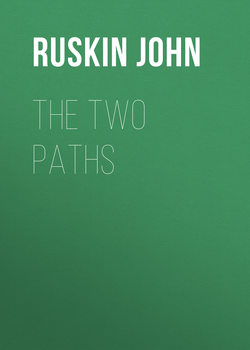The Two Paths

Реклама. ООО «ЛитРес», ИНН: 7719571260.
Оглавление
Ruskin John. The Two Paths
PREFACE
THE TWO PATHS
LECTURE I. THE DETERIORATIVE POWER OF CONVENTIONAL ART OVER NATIONS
LECTURE II. THE UNITY OF ART
LECTURE III. MODERN MANUFACTURE AND DESIGN
LECTURE IV. INFLUENCE OF IMAGINATION IN ARCHITECTURE
LECTURE V. THE WORK OP IRON, IN NATURE, ART, AND POLICY
APPENDICES
APPENDIX I
APPENDIX II
APPENDIX III
APPENDIX IV
APPENDIX V
Отрывок из книги
[Footnote: A few introductory words, in which, at the opening of this lecture, I thanked the Chairman (Mr. Cockerell), for his support on the occasion, and asked his pardon for any hasty expressions in my writings, which might have seemed discourteous towards him, or other architects whose general opinions were opposed to mine, may be found by those who care for preambles, not much misreported, in the Building Chronicle; with such comments as the genius of that journal was likely to suggest to it.]
As I passed, last summer, for the first time, through the north of Scotland, it seemed to me that there was a peculiar painfulness in its scenery, caused by the non-manifestation of the powers of human art. I had never travelled in, nor even heard or conceived of such a country before; nor, though I had passed much of my life amidst mountain scenery in the south, was I before aware how much of its charm depended on the little gracefulnesses and tendernesses of human work, which are mingled with the beauty of the Alps, or spared by their desolation. It is true that the art which carves and colours the front of a Swiss cottage is not of any very exalted kind; yet it testifies to the completeness and the delicacy of the faculties of the mountaineer; it is true that the remnants of tower and battlement, which afford footing to the wild vine on the Alpine promontory, form but a small part of the great serration of its rocks; and yet it is just that fragment of their broken outline which gives them their pathetic power, and historical majesty. And this element among the wilds of our own country I found wholly wanting. The Highland cottage is literally a heap of gray stones, choked up, rather than roofed over, with black peat and withered heather; the only approach to an effort at decoration consists in the placing of the clods of protective peat obliquely on its roof, so as to give a diagonal arrangement of lines, looking somewhat as if the surface had been scored over by a gigantic claymore.
.....
Now, you see the characteristics of this utterly dead school are, first the wilful closing of its eyes to natural facts;—for, however ignorant a person may be, he need only look at a human being to see that it has a mouth as well as eyes; and secondly, the endeavour to adorn or idealize natural fact according to its own notions: it puts red spots in the middle of the hands, and sharpens the thumbs, thinking to improve them. Here you have the most pure type possible of the principles of idealism in all ages: whenever people don't look at Nature, they always think they can improve her. You will also admire, doubtless, the exquisite result of the application of our great modern architectural principle of beauty—symmetry, or equal balance of part by part; you see even the eyes are made symmetrical—entirely round, instead of irregular, oval; and the iris is set properly in the middle, instead of—as nature has absurdly put it—rather under the upper lid. You will also observe the "principle of the pyramid" in the general arrangement of the figure, and the value of "series" in the placing of dots.
From this dead barbarism we pass to living barbarism—to work done by hands quite as rude, if not ruder, and by minds as uninformed; and yet work which in every line of it is prophetic of power, and has in it the sure dawn of day. You have often heard it said that Giotto was the founder of art in Italy. He was not: neither he, nor Giunta Pisano, nor Niccolo Pisano. They all laid strong hands to the work, and brought it first into aspect above ground; but the foundation had been laid for them by the builders of the Lombardic churches in the valleys of the Adda and the Arno. It is in the sculpture of the round arched churches of North Italy, bearing disputable dates, ranging from the eighth to the twelfth century, that you will find the lowest struck roots of the art of Titian and Raphael. [Footnote: I have said elsewhere, "the root of all art is struck in the thirteenth century." This is quite true: but of course some of the smallest fibres run lower, as in this instance.] I go, therefore, to the church which is certainly the earliest of these, St. Ambrogio, of Milan, said still to retain some portions of the actual structure from which St. Ambrose excluded Theodosius, and at all events furnishing the most archaic examples of Lombardic sculpture in North Italy. I do not venture to guess their date; they are barbarous enough for any date.
.....